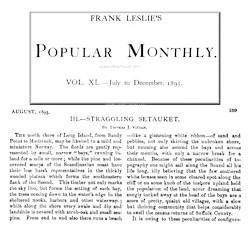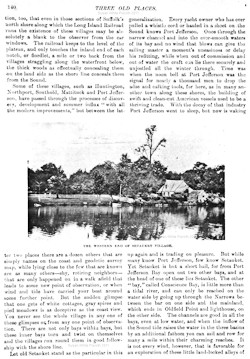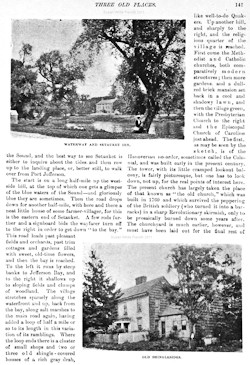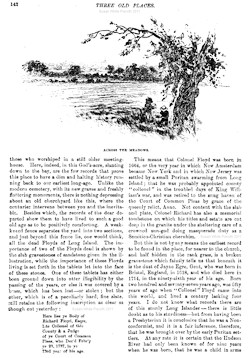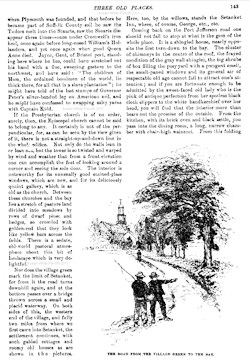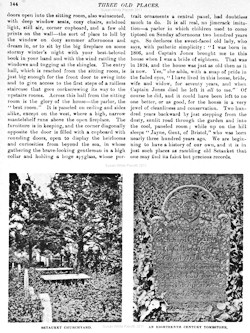| Part of title
page from Frank Leslie's Popular Monthly, Volume 40 and page 139 from
the August issue.. |
Page 140: "...
Every yacht owner who has
ever pulled
a whistle cord or hauled in a sheet on the Sound knows Port Jefferson.
... Time was when the noon bell at Port Jefferson was the signal
for nearly a thousand men to drop the adze and calking tools, for here,
as in many another town along these shores the building of swift and
clean-cut American vessels used to be a thriving trade. With the decay
of that industry Port Jefferson went to sleep, but now is waking up
again and is trading on pleasure. But while many know Port Jefferson,
few
know Setauket. Yet Setauket is but a short hail, for from Port
Jefferson
Bay open out two other bays, and at the head of one of these lies
Setauket. The other "bay" called Conscience Bay, is little more than a
tidal river and can only be reached on the water side by going up
through the Narrows between the bar on one side and the mainland which
ends in Oldfield Point and lighthouse on the other side...." |
Page 141: [Old
Shinglesides illustrated] "... walk over from Port
Jefferson. The start is
on a long half mile up the west side hill .... Then the road down for
another half-mile,... Up another hill, and sharply to the
right,
and the religious quarter of the village is reached. First come the
Methodist and Catholic churches, both comparatively modern structures;
then more gardens and a dull-red brick mansion set back in a cool and
shadowy lawn [the current location of the Setauket School] and then the
village green, with the Presbyterian Church to
the right and the Episcopal Church of Caroline just ahead. The first as
may be soon by the sketch is of the sketch is of the Hanoverian
no-order, sometimes called the Colonial, and was built early in the
present
century.... The present church has largely taken the place of that
known as "the old church," which was built in 1760 and which survived
the
peppering of the British soldiery (who turned it into a barracks) in a
sharp Revolutionary skirmish, only to be prosaically burned down some
years after..." |
Page 142:
"... old churchyard ... one would think
all the dead Floyds of Long Island. The importance of two of the Floyds
dead is shown by the slab gravestones of sandstone given in the
illustration, while the importance of these Floyds living is set forth
in the tablets let into tho face of these stones. One of these tablets
has either been ground down into utter illegibility by the passing of
the years, or else it was covered by a brass, which has been lost - or
stolen; but the other, which is of a peculiarly hard, fine slate, still
retains the following inscription as clear as though cut yesterday:
Here lies ye Body of
Richard Floyd Esqre,
late Collonel of this
County & a Judge
of ye Court of Common
Pleas, who Dec'd Febr'y
ye 28, 1737, in ye
73rd year of his age
This
means that Colonel Floyd was born in 1664, or the very year in which
New
Amsterdam became New York....
But this is not
by any means the earliest record to be found in the place, for nearer
to
the church, and half hidden in tho rank grass, is a broken gravestone
which faintly tells us that beneath it is the dust of Jayne Egre, Gent,
who was born in Bristol, England, in 1618, and who died here in 1714,
in
the ninety-sixth year of his age...." |
Page 143: "...If
the Presbyterian
church is of no order, surely then the Episcopal church cannot be to
belong to
any.... Not only do
the walls lean in or lean out, but the tower is so twisted and by wind
and
weather that from a front one can accomplish the feat of looking around
corner and seeing the side door. The interior noteworthy for its
unusually good stained-glass windows, which are new, and for its
deliciously quaint gallery,
which is as old as the church....
Coming back on the Port Jefferson
road one should not fail to stop at what is the gem of the whole place.
It is a shingled house nearly opposite the first turn down to the bay.
The cluster of chimneys in the centre of the roof the frayed condition
of the gray wall shingles the big shrubs of box filling the posy yard
with a pungent smell the small paned windows and its general air of
respectable old age cannot fail to attract one's attention and if you
are fortunate enough to be admitted by the sweet faced old lady who is
the pink of antique perfection from her spotless black cloth slippers
to the white handkerchief over her head you will find that the interior
more than bears out the promise of the outside ..." |
Page 144: "
[continued description of the house] ... It is all real, no
jimcrack imitation - a parlor in which children used to conic tiptoed
on
Sunday afternoons two hundred years ago. So declares the sweet-faced
old
lady, who says, with pathetic simplicity: "I was born in 1806 and
Captain
Jones brought me to this house when I was a bride of eighteen. That was
in 1824, and the house was just as old then as it is now. Yes," she
adds,
with a snap of pride in the faded eyes, "I have lived in this house,
bride,
wife and widow, for seventy years, and when Captain Jones died he left
it
all to me."..." |
